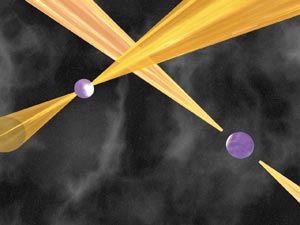
An international team of scientists working with the 64 m Parkes Telescope in Australia and the 76 m Lovell Telescope at the Jodrell Bank Observatory in the UK has found that the recently discovered neutron-star binary J0737-3039 is in fact a double-pulsar system. Because the two pulsars are very tightly orbiting each other, this discovery will allow unprecedented tests of Einstein’s general theory of relativity.
A neutron star is the collapsed core of a massive star that has ended its life in a supernova explosion. Neutron stars are about the same mass as the Sun, but only about 20 km across. These incredibly dense objects are called pulsars if they produce a pulsating radio signal, as first detected in 1967. A pulse occurs each time the rapidly spinning neutron star has its beam of radio waves pointing towards the Earth. Pulsars spinning at a rate of hundreds of times a second are more accurate time keepers than even the best atomic clocks on Earth, and this very precise timing allowed the discovery in 1990 of the two first extrasolar planets, orbiting the pulsar PSR 1257+12.
Observations of systems in which a pulsar is in orbit around another neutron star have been able to prove the existence of gravitational radiation as predicted by Albert Einstein and have provided very sensitive tests of his general theory of relativity. In 1993 Joseph Taylor and Russell Hulse earned the Nobel prize for their discovery of such a binary pulsar, PSR B1913+16, and their precise measurement of the rate of the binary system’s orbital decay through the emission of gravitational waves.
What makes the newly discovered neutron-star binary J0737-3039 special, is that its orbital period is only 2.4 hours, which is three times shorter than that of the Hulse-Taylor binary pulsar (Burgay et al. 2003). The two neutron stars orbit each other so tightly that the orbit would fit inside the Sun. Because of gravitational wave emission, the two stars will coalesce in only around 85 million years, sending an ultimate ripple of gravity waves across the universe. The discovery of this closely orbiting system implies that such coalescences must occur more frequently than was previously thought.
This result, published at the end of December 2003, proved however not to be the end of the story. The same team, from Australia, India, Italy and the UK, has now announced the detection of a pulsed signal from the second neutron star of the J0737-3039 system (Lyne et al. 2004). Already four different effects beyond those predicted by Newton’s laws of gravity have been measured and found to be completely consistent with Einstein’s general theory of relativity. On a time-scale of a few years, other relativistic effects should be detectable. Andrew Lyne of Manchester points out that, “While experiments on one pulsar in such an extreme system as this are exciting enough, the discovery of two pulsars orbiting one another will allow us to undertake precise new tests of general relativity and probe energetic physical processes that occur in the magnetosphere, or ‘extended atmosphere’, of a neutron star.”
Further reading
M Burgay et al. 2003 Nature 426 531.
A Lyne et al. 2004 Science (in press) http://arxiv.org/abs/astro-ph/0401086.
Picture of the month

While the two NASA rovers Spirit and Opportunity are rolling around on opposite sides of the red planet, the Mars Express orbiter of the European Space Agency has detected water ice for the first time at the south pole of Mars. This colour picture shows a channel (Reull Vallis) that was once formed by flowing water. The landscape is shown in perspective and is based on the three-dimensional measurements of the High Resolution Stereo Camera (HRSC) onboard the Mars Express. The area shown is 100 km across and is located to the east of the Hellas basin. (Courtesy ESA/DLR/FU Berlin, G Neukum.)








